Maps, Kettles and Inflatable Cobblestones: The Art of Playful Disruption in the City
 Friday, August 21, 2015 at 2:49PM
Friday, August 21, 2015 at 2:49PM Sam Hind
[ PDF Version ]
You cannot give instructions to a gigantic inflatable...
—Artúr van Balen and Verena Meyer, “You Cannot Give Instructions to a Gigantic Inflatable.”
During the 1950s and 1960s, the Situationists devised an array of playful interventions that could “awaken” urban inhabitants from the “onslaught” of the modern city and its assault on all other forms of life.[1] However, despite being politically active, their tactics—namely dérives or “drifts”—were designed to be implemented in the quotidian city, as techniques to subvert the everyday rather than as methods developed to be employed within protest events. As such, their utility in transforming them might seem limited. But play is integral to the very operation of many protest marches, demonstrations, and occupations. Think of the turtle outfits of the Seattle WTO demonstrations, the effigies of anti-American protests in Iran, Iraq, and the Philippines, or the V for Vendetta masks worn during the Occupy events.[2] Together, they illustrate what has been called “tactical frivolity,”[3][4] a form of public protest that is neither confrontational nor sub-missive, but humorous and whimsical. Here I discuss the ways in which Situationist tactics have been refracted through new kinds of objectives and arrangements during contemporary protest events, using the deployment of a map-based smartphone app called Sukey[5] during protests in London and the development of inflatable objects by an artistic group called the Eclectic Electric Collective[6] as examples. The app and the inflatables can be seen as subversive tools or “disobedient objects”[7] designed to fit incongruously into their respective protest environments disrupting and jarring the controlled, sanitized and spatially-restrained events. Their mode of doing so is playful, frivolous, and momentary; arguably in the spirit of Situationist tactics like the dérive. I argue that they are urban embodiments of jouissance,[8] playful articulations of political matters.
Spatial Tactics
Protest events sit somewhere between the meandering walks or dérives early Situationists de-signed to identify the “subtle moods and nuances” of the urban environment[9] in order to allow participants to counter the increasingly rational organization of the city,[10] and the visceral battle-field engagement that later interventions such as Alice Becker-Ho and Guy Debord’s A Game of War (1987) strategy game sought to simulate. They may be conceptualized as momentary suspensions of societal distinction aside from the everyday,[11] as “ephemeral moments of excess”[12] or opportunities to “let off steam.”[13] Despite an increasing militarization of protest policing in the US and Canada,[14] and unprecedented restrictions on the right to free assembly in the UK,[15] protest events continue to exercise a degree of volatility, intensity, and incalculability that cannot be found in the regulatory rhythms of the everyday, and cannot be captured in totality by the state. Many demonstrations are systematically defined, routed, calculated, regulated, and policed in order to foreclose future disruptions. However, as witnessed by the author at many student and anti-austerity demonstrations over the last four years in the UK, there is often an “escaping edge” to proceedings.[16] Protests are temporary events in which, as Esther Peeren suggests, territory is subjected to “an ongoing process of contestation” with “control only momentary and provisional.”[17] They rarely come into being as forecast events with knowable sizes, shapes, and dynamics, but emerge as unpredictable occasions with varied demands, situational tactics, and the potential for impulsive moments.
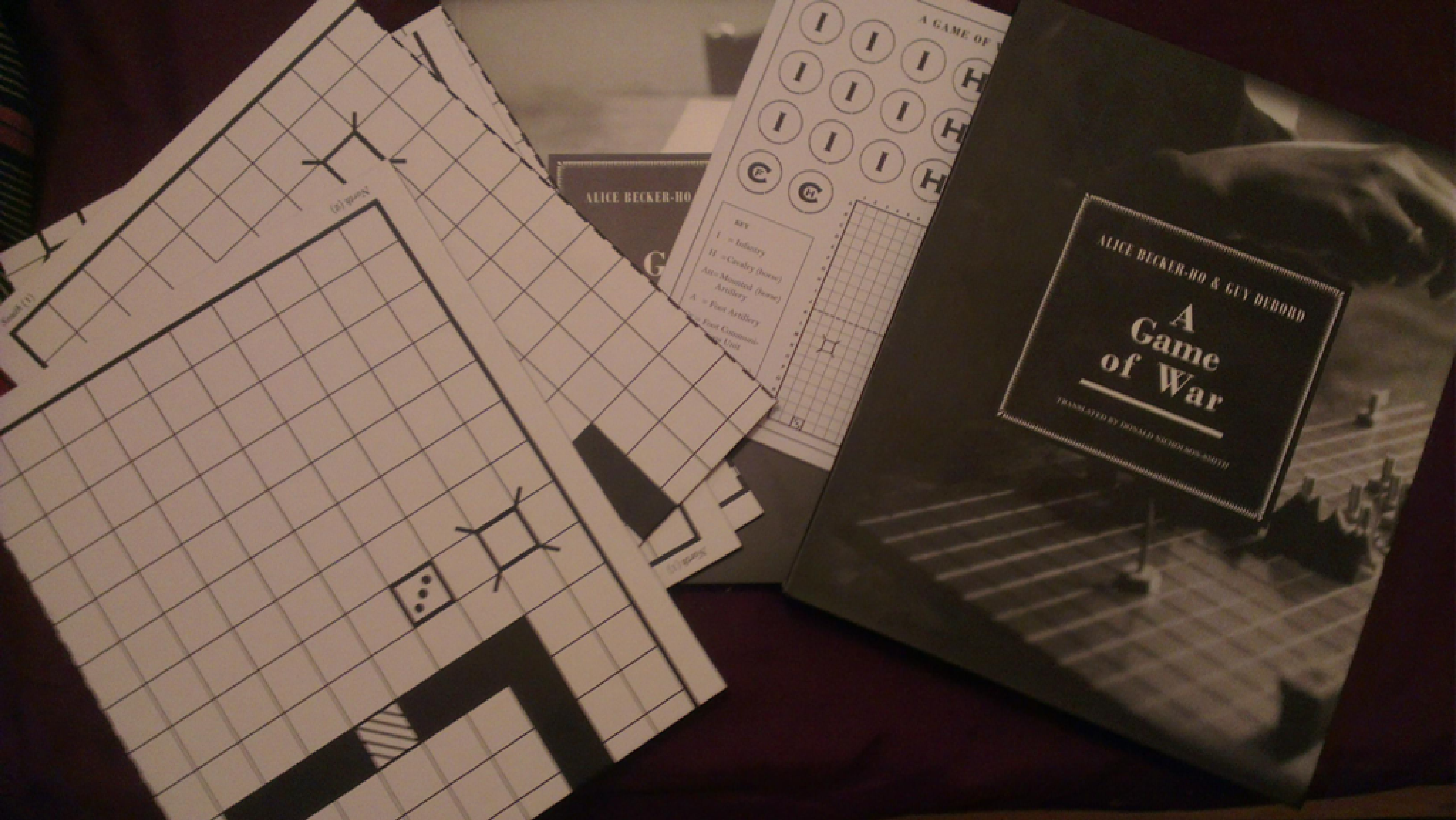
Figure 1. A Game of War, 1987
It is this provisionality that the Situationists sought to foster with their everyday dérives, but arguably failed to capture with A Game of War, a chess-style board game intended to simulate the interplay between strategic and tactical approaches to modern warfare.[18] At the escaping edge of the routed A-to-B-style protest events, cat-and-mouse games emerge that more aptly characterize the playful tactics that form the focus of the interrogation on offer here: a series of cunning maneuvers, or disordered degrees of play, [19][20] that embody these particular moments of urban resistance. A Game of War bore very little in common with the more imaginative tactical elements conceived in the early Situationist days. Although Becker-Ho and Debord had suggested the game was intended to echo “the combat...so characteristic” of poker,[21] in truth it was rather more methodical, embodying the pensive, calculative play of battleships, or in Alexander Galloway’s terms, akin to playing “chess with networks,”[22] in reference to its novel consideration of communication lines as integral to territorial conquest. Dérives they were not. Yet A Game of War was the closest any Situationist work had got to actually devising a practically and tactically-useful guide to territorial engagement. That it did so through a board game rather than any prose, missive, or communique is testament to the movement’s enduring playfulness. But how can we conceptualize the ludic ethic of contemporary protest events? Does it manifest itself more as a drifting psychogeography of the city or as a strategy game? How can we understand them as occasions in which individuals devise playful, urban interventions?
“Tactical frivolity” is the modern term given to such tactics, arising initially as a phrase to characterize the growing number of playful,[23] musical, and dance-led[24] “blocs” (assembled groups) attending anti-globalization and anti-capitalist demonstrations such as those in Seattle (1999) and Prague (2000). The UK activist group Reclaim the Streets is often argued to have been one of the first to instigate such actions, being involved in the organization of the so-called “Pink Bloc” at the demonstration in Prague.[25] However comic forms of protest, such as those initiated by Poland's Orange Alternative (1980s), certainly suggest a much longer deployment of the "tactically frivolous" in all but name.[26] Notions of the carnivalesque, discussed later, are even older.
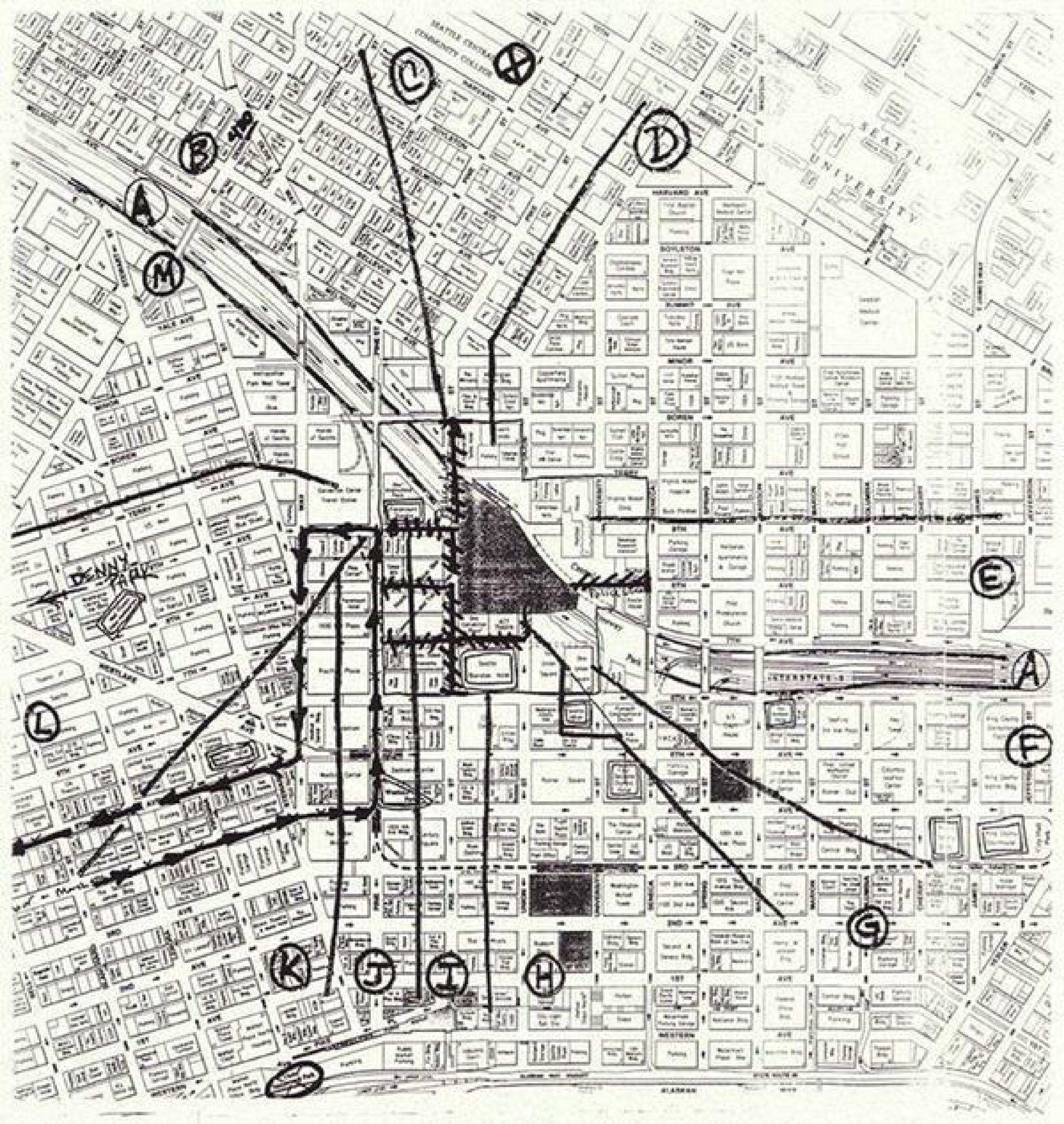
Figure 2. A ‘shut down’ or blockade map of Washington Convention & Trade Center in Seattle from the WTO demonstrations, 1999. Note the twelve “pie slices” for which each cluster of “blocs” or affinity groups were responsible for shutting down.
Accounts of events such as those in Prague suggested that activists sought to “defuse...confrontations with humor and ‘tactical frivolity,’”[27] alongside more common forms of direct action that saw police officers deploy “tear gas, water cannon and percussion grenades” in response.[28] Anti-globalization demonstrations of the time were characterized by various color blocs of like-minded protesters (black for anarchists/autonomists, pink for “carnivalistas and samba bands”[29] etc.); a new strategy designed to “temporarily align”[30] a raft of otherwise disparate protest groups (anarchists, international socialists, environmentalists etc.) into a coherent whole, in order to provide a diversity of offensive, defensive, and playful tactics. Since this time playful interventions outside of, and beyond, specifically tactically frivolous blocs have been witnessed at events across Europe. I now turn to the smartphone app Sukey, and the inflatable objects produced by the Eclectic Electric Collective to situate these developments.
Playful Maneuvers
Sukey's primary tactical aim was to combat a strategy deployed by the London Metropolitan Police Service (MPS), that gained “renewed infamy”[31] due to its indiscriminate deployment at student and anti-austerity demonstrations from 2010-2012. This tactic involved the containment of large groups of protesters in so-called “kettles”—named thusly because of the pressure exerted on those within them—in order to assuage their desire and ability to demonstrate. The combination of these maneuvers with subsequent data-gathering efforts by the police, generated the need for some kind of platform that could anticipate emergent containments. For a short while Sukey became that platform, being dubbed an “anti-kettling” app in the media.[32] Its use of a digital map to visualize these containments proved novel, inviting popular news outlets to speculate on the future of global protests in light of it.[33]
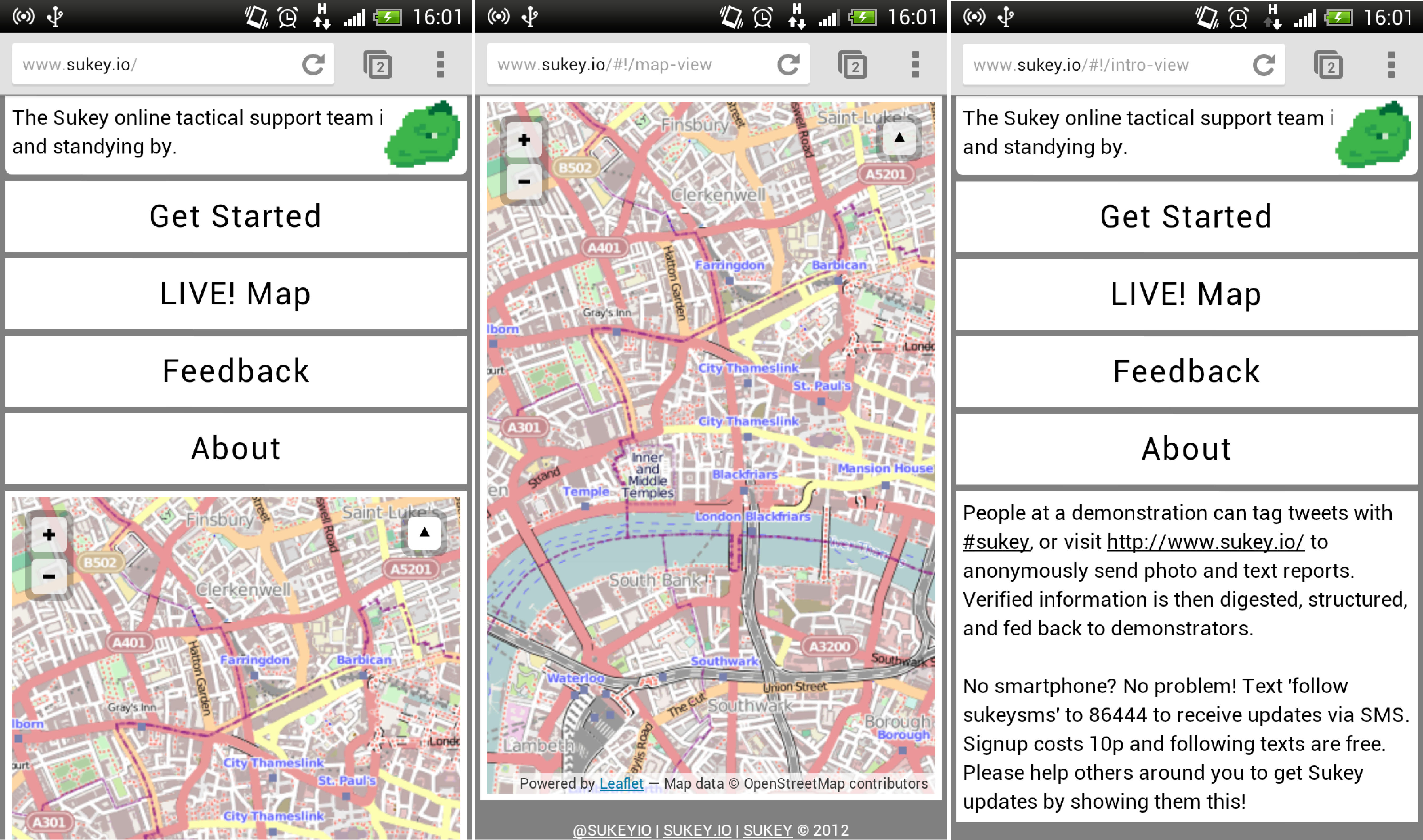
Figure 3. The Sukey platform
A number of technological features enabled protesters to not only anticipate these tactics, but to do so in playful ways. Although the app was built around a Google Maps interface for many of its early deployments—most notably at an anti-austerity demonstration in March 2011—the developers sought to use OpenStreetMap (OSM) for a “re-booted” version of the app at a student demonstration in October 2012, allowing users to encounter the urban environment in more pedestrian-friendly ways.[34] As a “collaborative, community-led”[35] mapping project, OSM has been built as an alternative to proprietary platforms such as Google Maps or the UK Ordnance Survey, with data contributions being uploaded by volunteers, mostly in the form of GPS traces. As there are no restrictions on its use, free as it is from copyright restrictions, the OSM platform has gradually come to rival, and in many places, supplant the utility of proprietary services. For protesters desiring to engage in the types of cat-and-mouse encounters emblematic of the student and anti-austerity demonstrations of 2010-2012, this shift proved useful. Unlike Google Maps, OSM is able to render ten road types, including four where vehicles do not have right-of-way[36]—critical at the time for protesters desiring to avoid police containments. Further, users were able to easily distinguish—through color, style and thickness—each road designation, making for quick, easy referencing when on the move. The cat-and-mouse tactics identified by the MPS at the time,[37] such as taking shortcuts, running down small alleys, hopping across green spaces, or jumping over walls, were to some degree stunted in these initial events by a reliance upon a platform designed with automobile navigation and “commodity-based reification”[38] in mind rather than playful urban intervention.
Across this period there was increasing concern amongst many groups including student bodies,[39] civil liberty campaigners,[40] and human rights lawyers that the increasingly draconian nature of protest policing in anticipation of, and during, such scheduled events in London was beginning to suppress legitimate rights to free assembly in the city. Organizers and participants continue to be forced to abide by an increasing number of strict, legal requirements designed to ensure “serious disruption to the life of the community is avoided.”[42] Notification for “public processions”[43] in London is required at least six days before planned events, and the final route must be approved by the police before consent is granted.[44] If organizers do not comply they may find themselves “criminally liable” as licensed taxi drivers were warned when the MPS discovered an unauthorized “procession of cabs”[45] was due to take place in the city. Other restrictions around Parliament Square (a public green space opposite the UK Parliament building) specifically prohibit the use of amplified noise equipment, “sleeping structures” or any kind of “sleeping equipment”[46] as Occupy Democracy protesters recently found out. It is in this context that protesters have sought new tactics and novel technologies with which to circumvent the micro-management of protest.
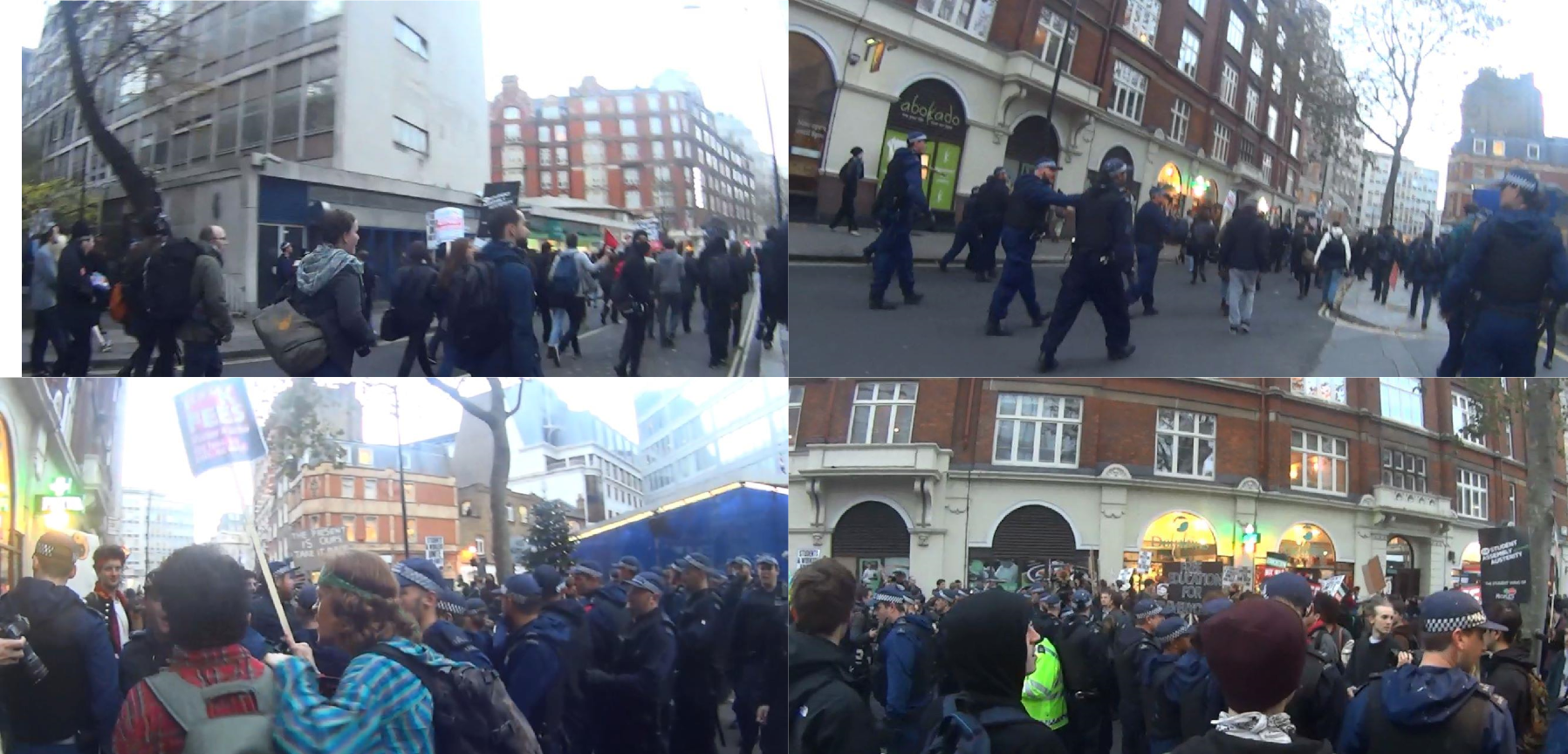
Figure 4. ‘Cat-and-mouse’ games in action at a student demo in London, November 2014. From above-left to below-right: a) protesters run down a side-street; b) police officers follow, with commands being issued to form a line; c) protesters are split into two groups as more officers consolidate; d) police form an impenetrable line preventing the continuation of the breakaway group of protesters.
The map, in the events discussed above, arguably became a game-board[47] for a multitude of spatially contingent face-offs between police units and protesters, in which anticipation of future maneuvers by each was sought, via the cartographic medium, but rarely ever guaranteed. In these rhizomatic[48] moments—with protesters eschewing the authorized and pre-agreed forms of “lawful” protest in order to avoid the kettles—new, inventive spatial practices invoking “intense pleasure and playfulness”[49] were cultivated, challenging what the Situationists called the “strange logic”[50] of the city. The deployment of the Sukey app enabled protesters to “buy-in" to the kind of poker battle Debord and Becker-Ho intended A Game of War to emulate. However, unlike A Game of War protesters were dealing with an unpredictable, and non-conformist game-board.
The Carnivalesque
But Sukey also became a platform not only to provide pragma (tactical support) to protesters desiring to stay safe, mobile, and informed[51] but also to augment the phantasma (carnivalesque nature) of the protest event,[52][53][54] amplifying farcical, surreal, or absurd moments within. Mikhail Bakhtin's analysis of the carnivalesque—a term used to denote occasions or events in which temporary subversion of everyday norms becomes possible through humor—is appropriate to describe specific tactics and moments within contemporary, urban protest events, although originally reserved by Bakhtin for medieval festivals as a whole.
During one demonstration in 2011, protesters were able to keep up-to-date with the movements of a Trojan horse effigy, and a hashtag—“FSU”—standing for “Fake Stallions Unite” was deployed by the Sukey team to enable protesters to track its location. The MPS were concerned enough at its possible impact that they sent a tweet urging protesters to continue on past it; its playful intervention providing a logistical headache, with its ceremonial burning becoming a focal point for joyful, and largely unpredicted, scenes towards the end of the official march.
"The Mighty Trojan Horse” is taken through the streets of London, in 2011.
At the same event, the Sukey team also set up a mock dating account to put “local activist lonely-hearts”[55] stuck in police kettles in touch with one other. The turning of an otherwise oppressive space into a temporary place for love and romance was one matched by similar artistic and playful interventions designed to alleviate boredom whilst being kettled, such as Laura Loftus' “Kettling Survival Kit”[56] and TerrorBull Games' “Metakettle.”[57] In each of these, there is an attempt to combat the logic of the kettle in which either confrontation with police officers or submission to the kettling tactic results in a “defeat” for protesters, either through their arrest or compliance. “Tactically frivolous” actions—i.e. those eschewing either offensive or defensive moves—turn the space of the kettle into one of love, romance, play or general camaraderie, resulting in a morale-boosting “victory” in which solidarity between those kettled is forged and play is cast as a “carnivalesque, disruptive, political mode of being.”[58]
These moments of “carnivalesque hacking”[59] provide creative possibilities that deliberately endanger the smooth running of “staged acts of civil disobedience,” replete with “permits and police escorts.”[60] In fact, they become tools for contingent action—devices with a latent volatility[61] representing the escaping edge of demonstrations, threatening the sanitized and “serious” spaces of urban resistance. What appeared to be a harmless cardboard effigy became a loaded symbolic tool through which protesters could articulate their playful actions. What, at face-value, appeared to be a mindless dating game, became a powerful means to alleviate the effects of a containment. Sukey became an instrument facilitating such happenings, providing a platform through which the carnivalesque could be performed, circulated, and thus transformed.
Further, the choice of inflatable objects by the Eclectic Electric Collective is an equally important one that makes connections between historical protest tactics, Situationist thought, and the urban environment in order to render demonstration as playful. The use of oversized items during protests—puppets, balloons, banners etc.—is nothing particularly new. David Graeber, for example, outlines how puppets have worked to “mock” and ridicule during specific protest events, rendering oppositional political figures as fools and villains.[62] Anti-Vietnam War demonstrations and Soviet-era marches both utilized their own forms of blow-up objects in order to draw attention to their own causes, to satirize political power, and to invoke playful gestures amongst participants.[63]
Inflatables also have a continued connection to progressive urban thought. The Parisian group Utopie, for example, sharing similarities with the work of Dutch Situationist artist Constant, hosted an exhibition entitled “Structures Gonflables” in 1968 to celebrate all things architecturally inflatable from chairs to whole buildings to emphasize the potential of transient, recombinable urban forms.[64][65]
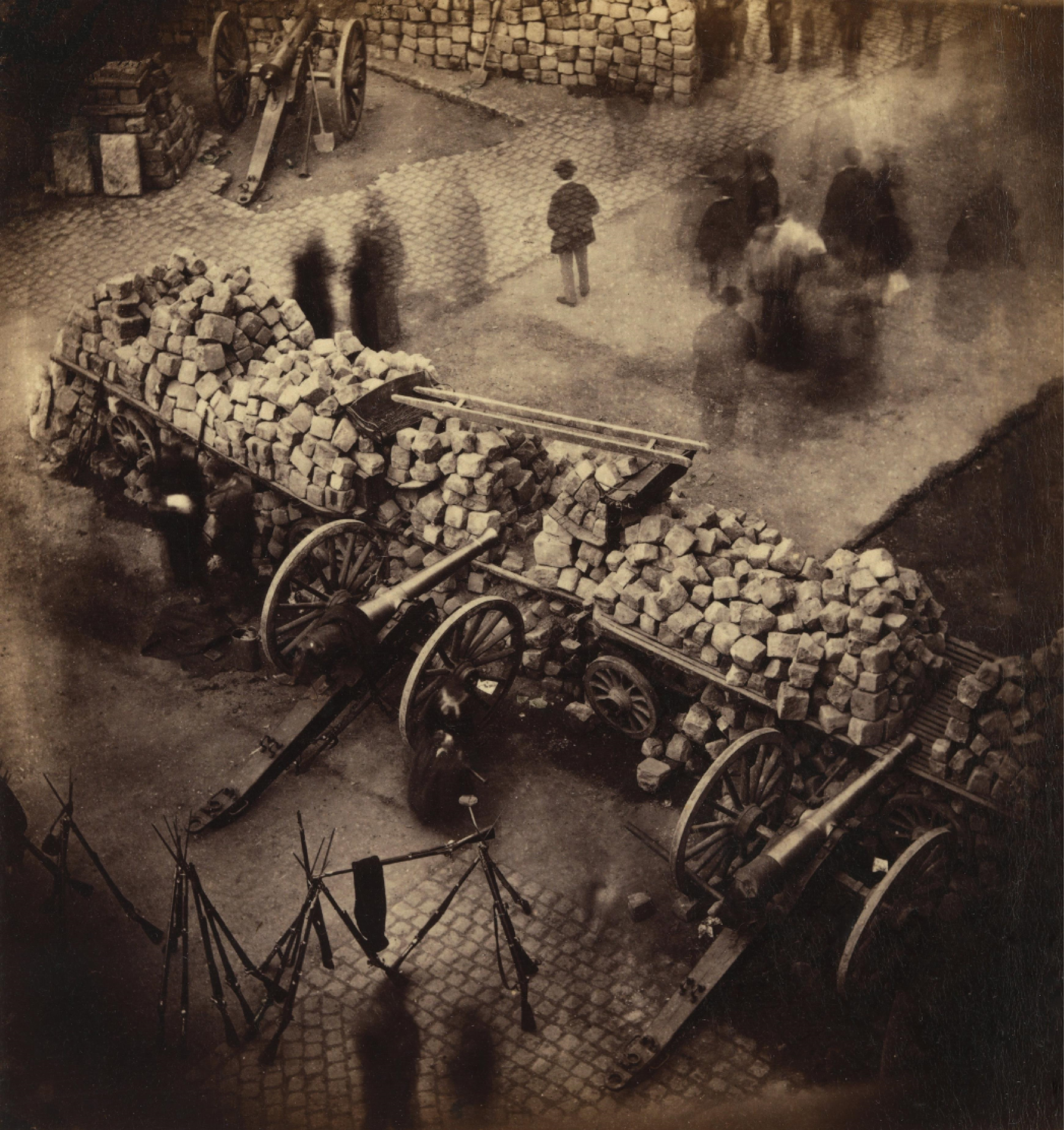
Figure 5. A Barricade of the Paris Commune, April 1871, by Pierre-Ambrose Richebourg (1810-1893). Entry 284087, www.metmuseum.org
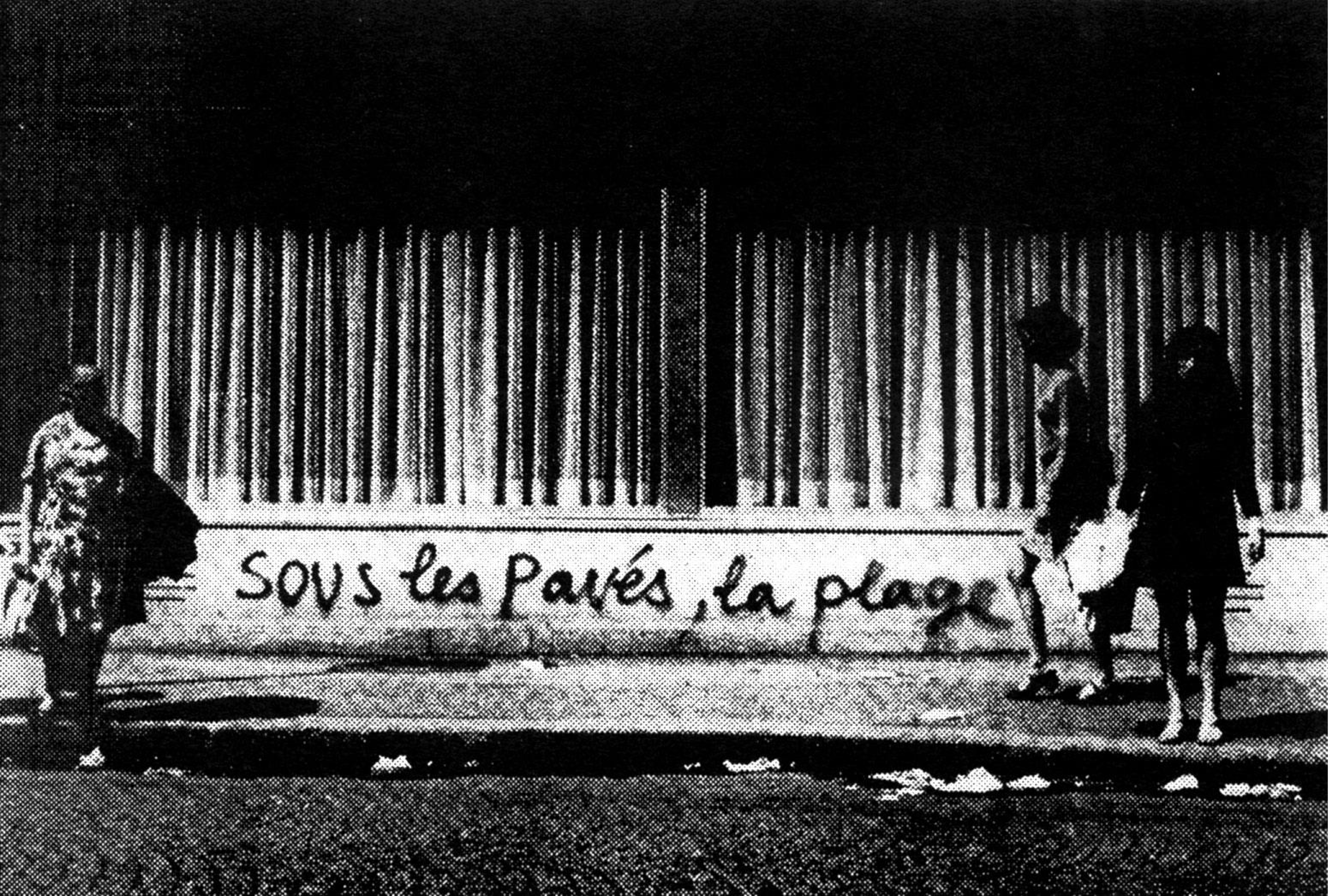
Figure 6. “Sous les pavés, la plage!” (“Under the cobblestones, the beach.”)
The production of an inflatable cobblestone for demonstrations in Barcelona and Berlin (2010) inverted the cobblestone's fierce materiality; long seen as a tool for the construction of urban barricades, most memorably perhaps during the Paris Commune (1871) when they were re-purposed to resist the advances of the French Republican army. Many at the time of the Commune believed the new macadamized surfaces of Haussmann's Paris were "designed to prevent [radicals] from converting cobblestones into barricades,"[66] and as such vehemently opposed the kinds of radical urban re-designs the Situationists would later also oppose. As a constituent of the very fabric of the city, the cobblestone's re-appropriation and militarization—removed from everyday use and implanted within a new radical situation—has continued to resonate with social movements worldwide. The famous Situationist slogan "Sous les pavés, la plage!" ("Under the cobblestones, the beach!")[67] from the events across France in 1968 was a direct call to re-appropriate the city in such a manner. Far from an archaic practice, the lifting of them from the road surface to form barriers and brick mounds is still witnessed today, most recently in Istanbul (2013). Thus, it continues to be used as a physical building block in urban resistance.
Inflatable Cobblestone, Berlin 2012
Inflatable Cobblestone, Deflated, Berlin 2012
But whereas the actual cobblestone resists transformation from all but the strongest or sharpest of blows from a hammer, the inflatable has an array of obvious weaknesses. It is floating, ephemeral, and (relatively) harmless in its deployed form. It can be picked up and put down at will. But like a balloon it can be punctured and deflated. The inflatable works, however, as a tactical aid, precisely because of this fragility. Its precarious form augments the event by providing playful interaction, becoming passed and thrown above the crowd like a beach ball. In previous events police officers have become disarmed by the frivolity of the performance and sought to prevent such interaction, with inflatables commonly confiscated and deflated.[68] In so doing it further works to mock and ridicule the oppositional forces, like the puppet, as the unwieldy item struggles to be contained. In exposing the ruthlessness of such action, protesters are able to lay bare otherwise invisible or elusive power relations at play during demonstrations. Protesters use them as tactical props for the carnivalesque, in order to bring participants together into collective solidarity.
In this short piece I have suggested that two devices, an "anti-kettling" app and an inflatable cobblestone, have demonstrated the prevalence of playful interventions within the urban protest event. Their separate deployments in London, Barcelona, and Berlin artfully build on the playful tactics of the Situationists, bringing the cartographic, the gestural, and the carnivalesque together. These new arrangements are built to work beyond everyday urban life, during the intense, ephemeral moments of protest events, invoking new, mobile digital technologies and light-weight, inflatable materials. Their efficacy depends on the successful mobilization of ludic action; playful articulations of political matters.
Acknowledgements
I would like to thank attendees of, and fellow presenters in, the 'Digital Cartographies II' session at the Crossroads Conference in Cultural Studies in Tampere, Finland for their thought-provoking questions and discussions that have allowed me to refine the argument above. Thanks to Sybille Lammes for reading previous draft versions. Further thanks are due to Oriana Eliçabe for allowing me to reproduce her inflatable cobblestone image. Any mistakes within are wholly my own.
Funding
This research has received funding from the European Research Council under the European Community's Seventh Framework Programme (FP7/2007-2013) / ERC Grant agreement no. 283464.
Notes
[1] Eric Swyngedouw, "The Strange Respectability of the Situationist City in the Society of the Spectacle," International Journal of Urban and Regional Research 26, no.1 (2002): 153-166.
[2]For a good range of debates on the latter, see Jonathan Jones, “Occupy’s V for Vendetta protest mask is a symbol of festive citizenship,” Guardian, 4 November 2011, accessed 8 December 2014, http://www.theguardian.com/commentisfree/2011/nov/04/occupy-movement-guy-fawkes-mask; Teo Ballvé, “The Mask of ‘Anarchy,’ Territorial Masquerades, 7 November 2011, accessed 8 December 2014, http://territorialmasquerades.net/the-mask-of-%E2%80%98anarchy%E2%80%99/; Stuart Elden, “V for Visibility,” Interstitial, March, 2011, accessed 8 December 2014, http://interstitialjournal.files.wordpress.com/2013/03/elden-occupy.pdf.
[3] Artúr van Balen, "Inflatables for Protest: An Interview with Artúr van Balen / Tools for Action," V&A, 3 July 2014, accessed 10 July 2014, http://www.vam.ac.uk/blog/disobedient-objects/tools-for-action-interview-with-artur-van-balen.
[4] Amory Starr, Global Revolt: A Guide to the Movements Against Globalization (London: Zed Books, 2005), 242.
[5] See http://www.theguardian.com/uk/2011/feb/02/inside-anti-kettling-hq for a good overview on the application and its genesis.
[6] See http://eclectic-electric-collective.blogspot.co.uk/. The group now operate under the banner Tools for Action (http://www.toolsforaction.net/).
[7] 'Disobedient Objects' is the name of a recent exhibition at the Victoria & Albert Museum in London on the role of such objects in forms of popular protest. See: http://www.vam.ac.uk/content/exhibitions/disobedient-objects/.
[8] Swyngedouw, "The strange respectability," 163.
[9] Andy Merrifield, Guy Debord (London: Reaktion Books, 2005), 30.
[10] See Simon Sadler, The Situationist City (Cambridge, MA: MIT Press, 1999) for a detailed overview.
[11] Michael Lane Bruner, "Carnivalesque Protest and the Humorless State," Text and Performance Quarterly 25, no. 2 (2005): 136-155.
[12] Sebastián Cobarrubias and John Pickles, "Spacing Movements: The Turn to Cartographies and Mapping Practices in Contemporary Social Movements," in The Spatial Turn: Interdisciplinary Perspectives, ed. Barney Warf and Santa Arias (London: Routledge, 2009), 37.
[13]Katherine Ainger, Graeme Chesters, Tony Credland, John Jordan, Andrew Stern and Jennifer Whitney ed., We Are Everywhere: The Irresistible Rise of Global Anticapitalism (London: Ver-so, 2003), 182.
[14]Lesley J. Wood, Crisis and Control: The Militarization of Protest Policing (London: Pluto, 2014).
[15]David Graeber, "Occupy Democracy is not considered newsworthy. It should be," Guardian, 27 October 2014, accessed 27 October 2014, http://www.theguardian.com/commentisfree/2014/oct/27/occupy-democracy-london-parliament-square.
[16] Ben Anderson and Paul Harrison, "The Promise of Non-Representational Theories," in Taking-Place: Non-Representational Theories and Geography, ed. Ben Anderson and Paul Harrison (Farnham: Ashgate, 2010), 20.
[17] Esther Peeren, "Carnival Politics and the Territory of the Street," Thamyris / Intersecting 14, (2007): 69.
[18]McKenzie Wark, "The Game of War: Debord as Strategist," Cabinet, Spring, 2008, accessed 10 July 2014, http://www.cabinetmagazine.org/issues/29/wark.php.
[19]Chris Perkins, "Playing with Maps," in Rethinking Maps, ed. Martin Dodge, Rob Kitchin and Chris Perkins (London: Routledge, 2009), 170.
[20]Brian Sutton-Smith, The Ambiguity of Play (Cambridge, MA: Harvard University Press, 1997).
[21]Alice Becker-Ho and Guy Debord, A Game of War (London: Atlas Press, 2006 [1987]), 156.
[22]Alexander Galloway, "The Game of War: An Overview," Cabinet, Spring, 2008, accessed 10 July 2014, http://www.cabinetmagazine.org/issues/29/galloway.php.
[23]Kate Evans, "It's Got To Be Silver and Pink: On the Road with Tactical Frivolity," in We Are Everywhere: The Irresistible Rise of Global Anticapitalism, ed. Katherine Ainger, Graeme Chesters, Tony Credland, John Jordan, Andrew Stern and Jennifer Whitney (London: Verso, 2003), 290-295.
[24]See video footage of 'Pink Bloque', a 'Chicago-based feminist street dance troupe' formed in 2002: http://vimeo.com/33434583.
[25]Graeme Chesters and Ian Welsh, Complexity and Social Movements: Multitudes at the edge of chaos (London: Routledge, 2006), 43.
[26]Bruner, "Carnivalesque Protest and the Humourless State," 144.
[27]John Vidal and Kate Connelly, "Barricades burn in the battle of Prague," Guardian, 27 September 2000, accessed 5 November 2014, http://www.theguardian.com/business/2000/sep/27/imf.economics1.
[28]Ibid.
[29]Ibid.
[30]Chesters and Welsh, Complexity and Social Movements, 48.
[31]Lesley J. Wood, Crisis and Control: The Militarization of Protest Policing (London: Pluto, 2014), 37.
[32]Patrick Kingsley, "Inside the Anti-kettling HQ," Guardian, 3 February 2011, accessed 4 Feb-ruary 2011, http://www.theguardian.com/uk/2011/feb/02/inside-anti-kettling-hq.
[33]Alex Hudson and Peter Price, "How is Technology Changing Protests?" BBC, 12 April 2011, accessed 10 May 2011, http://news.bbc.co.uk/1/hi/programmes/click_online/9451521.stm.
[34]For a comparison, try using http://tools.geofabrik.de/mc/. Place Google Maps and OSM side-by-side. Zoom into a place that has properly designated highways and non-designated paths, alleys or spaces. Parks are especially good examples. Google does poorly rendering inclines, steps, small walls and the like that whilst impassable for cars, can be traversed on foot.
[35]Chris Perkins and Martin Dodge, "The Potential of User-generated Cartography: A Case Study of the OpenStreetMap Project and Mapchester Mapping Party," North West Geography 8, no. 1 (2008): 18-32.
[36]These are: motorways, trunk roads, primary roads, secondary roads, unsurfaced roads, tracks, byways, bridleways, cycleways, and footways. See http://www.openstreetmap.org/key. Google has only six designations, these are: motorways, major roads, primary roads, secondary roads, paths, and tracks.
[37]Bob Broadhurst, "TUC March - Latest News," Metropolitan Police Service, March 27, 2011, accessed October 30, 2014, http://content.met.police.uk/News/TUC-March--Latest-News/1260268742383/1257246745756.
[38]Alastair Bonnett, "The Nostalgias of Situationist Subversion," Theory, Culture & Society 23, no. 5 (2006): 30.
[39]National Union of Students, "Defend the Right to Protest," NUS, 9 February 2012, accessed 5 November 2014, http://www.nus.org.uk/cy/news/defend-the-right-to-protest/.
[40]"Liberty's Report on Legal Observing at the TUC March for the Alternative," Liberty, March, 2011, accessed 5 November 2014, https://www.liberty-human-rights.org.uk/sites/default/files/libertys-report-on-legal-observing-at-the-tuc-march-for-the-alternative.pdf.
[41]Michael Mansfield, "Our Right to Protest is Under Attack," Guardian, 1 May 2012, accessed 30 October 2014, http://www.theguardian.com/commentisfree/2012/may/01/right-to-protest-under-attack.
[42]Metropolitan Police Service, "Open appeal to organizers of demonstrations to take place on 5 November," Metropolitan Police Service, 30 October 2014, accessed 30 October 2014, http://content.met.police.uk/News/Open-appeal-to-organisers-of-demonstrations-to-take-place-on-5-November/1400027433405/1257246745756.
[43]The legal term under the UK Public Order Act (1986) for moving protest events.
[44]Metropolitan Police Service, "Notification of Public Procession," Metropolitan Police Service, accessed 30 October 2014, http://content.met.police.uk/cs/Satellite?blobcol=urldata&blobheadername1=Content-Type&blobheadername2=Content-Disposi-tion&blobheadervalue1=application%2Fpdf&blobheadervalue2=inline%3B+filename%3D%22448%2F594%2F3175.pdf%22&blobkey=id&blobtable=MungoBlobs&blobwhere=1283526934552&ssbinary=true.
[45]Metropolitan Police Service, "Important Request from Police to Licensed #Taxi Drivers re: Proposed Protest Weds 11 June #London #LTDA #LCDC #Unite," 9 June 2014, accessed 5 November 2014, https://twitter.com/MetPoliceEvents/status/476006876606656512.
[46]Liberty, "Protest around Parliament," Liberty, date unknown, accessed 30 October 2014, https://www.liberty-human-rights.org.uk/human-rights/free-speech-and-protest/protest/protest-around-parliament.
[47]Sybille Lammes, "The Map as playground: Location-based Games and Cartographical Daily Practices," Proceedings of DIGRA: Think, Design, Play (2011), accessed 11 July 2014, http://www.digra.org/wp-content/uploads/digital-library/11310.35282.pdf.
[48]Gilles Deleuze and Felix Guattari, A Thousand Plateaus (London: Continuum, 2004 [1987]).
[49]Swyngedouw, "The Strange Respectability," 157.
[50]Sadler, The Situationist City, 82.
[51]Sukey's primary aim was to 'keep protesters safe, mobile and informed' as their much-repeated slogan claimed.
[52]Bruner, "Carnivalesque Protest and the Humourless State," 143.
[53]Peeren, "Carnival Politics."
[54]Andrew Robinson, "Bakhtin: Carnival against Capital, Carnival against Power," Ceasefire, 9 September 2011, accessed 10 July 2014, http://ceasefiremagazine.co.uk/in-theory-bakhtin-2/.
[55]Sukey Dating, Twitter, accessed 31 October 2014, https://twitter.com/SukeyDating.
[56]See http://cargocollective.com/lauraloftus/Kettling-Survival-Kit.
[57]See https://www.terrorbullgames.co.uk/games/metakettle_pnpgame.php.
[58]Miguel Sicart, Play Matters (Cambridge, MA: MIT Press, 2014), 75.
[59]St. John, "Protestival," 172.
[60]Ainger et al., We Are Everywhere, 174.
[61]Robinson, "Bakhtin."
[62]David Graeber, "On the phenomenology of giant puppets: Broken windows, imaginary jars of urine, and the cosmological role of the police in American culture," Libcon, 5 April 2007, accessed 10 July 2014, http://libcom.org/files/puppets.pdf.
[63]van Balen, "Inflatables for protest."
[64]Marc Dessauce, The Inflatable Moment: Pneumatics and Protest in '68 (New York:Princeton Architectural Press, 1999).
[65]Swyngedouw, "The Strange Respectability," 155.
[66]David Harvey, Paris, Capital of Modernity (London: Routledge, 2003), 207.
[67]See McKenzie Wark, The Beach Beneath the Streets: The Everyday Life and Glorious Times of the Situationist International (London: Verso, 2011).
[68]van Balen, "Inflatables for Protest."
Sam Hind is a PhD candidate in the Centre for Interdisciplinary Methodologies, University of Warwick, UK. He is attached to an ERC funded project entitled ‘Digital Mapping Practices as New Media Cultures’. His thesis is an investigation into the transformational role of digital mapping technologies in protest events. More broadly, he is interested in conceptualizing how digital maps are enrolled into everyday life.